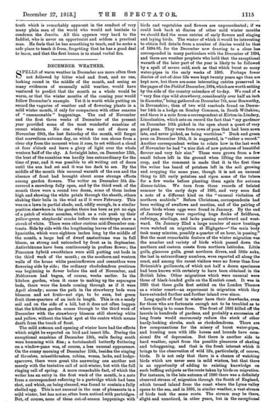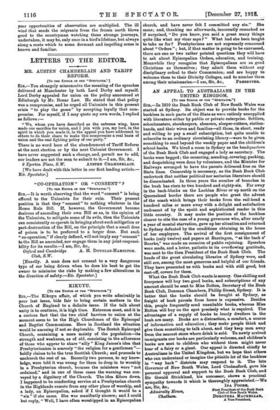DECEMBER WEATHER.
SPELLS of warm weather in December are more often than not followed by bitter wind and frost, and no one, looking round in the middle of the month, and seeing so many evidences of unusually mild weather, would have ventured to predict that the month as a whole would be warm, or that the winter months of the coming year would follow December's example. Yet it is worth while putting on record the vagaries of weather and of flowering plants in a mild winter month, if only for comparison with other seasons of " unseasonable " happenings. The end of November and the first three weeks of December of the present year provided some of the most wonderful sunshine of recent winters. No one who was out of doors on November 29th, the last Saturday of the month, will forget that marvellous autumn day, on which the sun shone from a clear sky from the moment when it rose, to set without a cloud at four o'clock and leave a glory of light over the whole western half of the sky. A fortnight later, on December 13th, the heat of the sunshine was hardly less extraordinary for the time of year, and it was possible to sit writing out of doors until the sun had set and it was too dark to see. By the middle of the month this unusual warmth of the sun and the absence of frost had brought about some strange effects among garden flowers. The writer on December 5th dis- covered a snowdrop fully open, and by the third week of the month there were a round two dozen, some of them inches high and showing the white petals through the sheath, others shaking their bells in the wind as if it were February. This was on a lawn in partial shade, and, oddly enough, in a similar position elsewhere in the garden there has been as yet no sign of a patch of winter aconites, which as a rule push up their yellow-green shepherds' crooks before the snowdrops show a streak of white, There were other curious mid-December con- trasts. Side by side with the lengthening leaves of the museari hyacinths, which were eighteen inches long by the middle of the month, a large bed of dwarf nasturtiums was in full bloom, as strong and untouched by frost as in September. Antirrhinums have been continuously in profuse flower ; the Penzance hybrid sweetbriars were still putting out buds in the third week of the month ; on the southern and western walls of the house white passionflowers and ceanothus were flowering side by side; the ordinary rhododendron pontieum was beginning to flower before the end of November, and Nobleanum bad begun, of course, weeks earlier. In the kitchen garden, when it came to making up the asparagus beds, there were the heads coming through as if it were April already ; across the path in the strawberry beds were blossom and set fruit—not ripe, to be sure, but green fruit three-quarters of an. inch in length. This is on a sandy soil and on the side of a hill, but it does not often happen that the kitchen garden comes through to the third week of December with the strawberry blossom still showing white and yellow, without the black spot at the centre which means death from the touch of frost.
The mild autumn and opening of winter have had the effects which might be expected on bird and insect life. During the exceptional sunshine of December 13th, walls facing south were humming with flies ; a tortoiseshell butterfly fluttering on a window-pane was, of course, a less unusual appearance. On the sunny morning of December 15th, besides the singing of thrushes, misselthrushes, robins, wrens, larks, and hedge- sparrows, there were great tits answering one another not merely with the tentative call of mid-winter, but with the full ringing call of spring. A more remarkable fact, of which the writer has an entry in the first week of the month, is a note from a correspondent referring to a partridge which had been shot, and which, on being cleaned, was found to contain a fully shelled egg. This is not unusual in the case of pheasants in a mijd winter, but has not so often been noticed with partridges. But, of course, none of these out-of-season happenings with birds and vegetables and flowers are unprecedented; if we could look back at diaries of other mild winter months we should find the same entries of early flowers and singing and laying birds. The winter of which it would be interesting to obtain full details from a number of diaries would be that of 1894-95, for the December now drawing to a close has corresponded in many particulars with the December of 1894, and there are weather prophets who hold that the exceptional warmth of the later part of the year is likely to be followed by a spell of severe cold, such as that which burst so many water-pipes in the early weeks of 1895. Perhaps fewer diaries of out-of-door life were kept twenty years ago than are kept now, but there are some interesting entries preserved in the pages of the Field of December,1894, which are worth setting by the side of the country calendars of to-day. We read of a "very fine ripe wild strawberry, considerably over half an inch in diameter," being gathered on December 7th, near Beaworthy, in Devonshire; then of two wild rosebuds found on Decem- ber 14th in a hedge on Semley Common, in South Wiltshire; and there is a note from a correspondent at Kirton-in-Lindsey, Lincolnshire, which sets on record the fact that "my gardener on December 10th picked in the open about a quart of very good peas. They were from rows of peas that had been sown late, and never picked, as being worthless." Duck and green peas on December 10th, it is suggested, is "rather a record." Another correspondent writes to relate how in the last week of November he had "a nice dish of new potatoes of beautiful flavour and very fair size." These were grown from a few small tubers left in the ground when lifting the summer crop, and the comment is made that it is the first time the writer has heard of potatoes left in the soil growing and cropping the same year, though it is not an unusual thing to lift early potatoes and ripen some of the tubers for a few weeks before planting theta again for autumn dinner-tables. We turn from these records of belated summer to the early days of 1895, and very soon find a note of a different kind on the "unusual visitation of northern seabirds." Before Christmas, correspondents had been writing of swallows and martins, and of the pairing of other birds whose eggs were found in January. By the end of January they were reporting huge flocks of fieldfarea, redwings, starlings, and larks passing southward and west- ward. On January 22nd a large number of snow buntings were watched on migration at Highgate—" the main body took many minutes, possibly a quarter of an hour, in passing." But the most remarkable feature of the winter migration was the number and variety of birds which passed down the northern and eastern coasts from northern latitudes. Little gulls, glaucous gulls, great northern divers, and little auks, the last in extraordinary numbers, were reported all along the coast, and among the rarest visitors were no fewer than four Briinnich's guillemots, of which not half a dozen specimens had been known with certainty to have been obtained in the British Isles. Other migrations which were unusual were those of black-headed gulls on the Kentish coast. It was in 1895 that these gulls first settled on the London Thames as a winter resort—an experiment in migration which they have extended further and further inland ever since.
Long spells of frost in winter have their drawbacks, even for those who are fortunate enough not to be troubled as to where firing is to come from. The frost of 1895 killed off the laurels in hundreds of gardens, and probably a succession of long frosts would enormously reduce the stock of other hardy-looking shrubs, such as rhododendrons. There are few compensations for the misery of burst water-pipes, and hunting men with idle horses and hounds have occa- sional fits of depression. But there is another side to bard weather, apart from the possible pleasures of skating and tobogganing, and that is the fresh interest which it brings to the observation of wild life, particularly, of course, birds. It is not only that there is a chance of watching birds which are never seen in mild winters, but that there is an opportunity of adding to existing knowledge on such baffling subjects as the route taken by birds on migration. For instance, in the late autumn of 1890 there was a definitely observed stream of, migration through the South of England, which turned inland from the coast where the Lyme valley opens to the sea, and in 1895, in similar weather, a vast stream of birds took the same route. The stream may be there, slight and unnoticed, in other years, but in the exceptional
year opportunities of observation are multiplied. The ill wind that sends the migrants from the frozen north blows good to the countryman watching these strange journeys, undertaken, it may be, only once in a bird's lifetime, but always along a route which to some dormant and impelling sense is known and familiar.



































 Previous page
Previous page